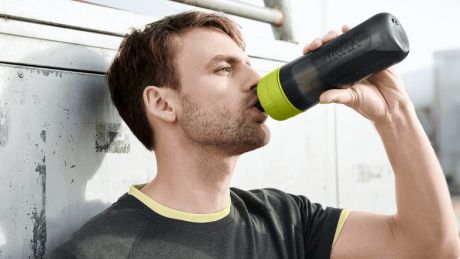How Much Water Should You Drink?
It’s not a one-size-fits-all answer. Take the test, and hydrate with confidence

You know you should probably be drinking more water, but how much exactly? The recommended daily intake from the European Food Safety Authority is 2,500ml a day for men and 2,000ml for women, but it’s not quite as simple as that: your activity levels, environment, eating habits and physiology all play a part. The questions below will tell you everything you need to know, so check them off occasionally to make sure you’re getting your hydration right.
How big are you?
It seems obvious, but it’s worth mentioning: if you’re heavier or taller, you need more water. Adjust your intake accordingly. It’s also worth mentioning that if you’re trying to lose fat, adequate hydration will ‘liberate’ your body’s stored fat and help your metabolism to operate properly, meaning you’ll shed kilos faster.
How much do you sweat?
If you’re training a lot, measuring your ‘sweat rate’ is one of the smartest ways to work out just how much you need to top up. For the simplest way to test it – as used by Ironman athletes and professional runners – do a warm-up to the point where you start sweating, go to the loo if you need to, then weigh yourself on a scale. Next, work out for 30 minutes – it’s OK to hydrate during this, but keep track of how much you drink. At the end, weigh yourself again and multiply the difference in weight by two to get your hourly sweat rate. Generally speaking, this’ll be higher if you’re a male or extremely fit. Then rehydrate accordingly.
How hot is it?
Even if you don’t notice it, you lose fluid faster in hotter conditions. You’ll also be losing sodium through sweat – in extreme cases this might mean you need to top up on electrolytes, but normally lightly salting your food should be enough to keep up.
How much veg do you eat?
Water from food all counts to your total, and if you’re going over and above the five-a-day recommendation you might already be getting enough. Cauliflower, aubergine, spinach and broccoli are all more than 90% water by weight, while celery and cucumbers are closer to 95%. Snack on them, steam them or throw them in a blender – it all counts.
How does your pee look?
Urine color is one of the best markers of your hydration status. Generally, the lighter the color, the more hydrated you are: when dehydrated, your kidneys, which filter waste, tell the body to retain water. Therefore, we have less water in our urine, which causes it to become more concentrated and darker. If it’s light yellow, you’re probably getting enough fluids. If it’s dark or smells strongly, you probably need more.
How much alcohol have you had?
Alcohol is a diuretic, which means that it acts on the kidneys to make you pee out much more than you take in – and it also reduces the production of a hormone called vasopressin, which tells your kidneys to reabsorb water rather than flush it out through the bladder. For every 1g of alcohol drunk, urine excretion increases by 10ml, which is why ‘breaking the seal’ is such a problem in the pub – your body’s reacting to the diuretic effect, not just the fluid you’ve taken in. Dehydration can be a problem when you’re drinking – so stick to the NHS guidelines, take at least 48 hours off booze a week, and try to sip regular water in any boozing session.
How thirsty are you?
Some scientists suggest this is the real key. Your body’s a fine-tuned instrument, evolved to self-regulate most of the time. In a lot of cases, thirst (or hunger, which can confuse your body’s mechanisms) is enough of an indicator that you need to top up.
Now read up on why you still aren’t drinking enough water
And find more ways to #swapforgood with the BRITA fill&go Active
Buy a BRITA fill&go Active now for just £7.99 (normally £12.99) BUY NOW
Sign up for workout ideas, training advice, reviews of the latest gear and more.
Coach is a health and fitness title. This byline is used for posting sponsored content, book extracts and the like. It is also used as a placeholder for articles published a long time ago when the original author is unclear. You can find out more about this publication and find the contact details of the editorial team on the About Us page.

